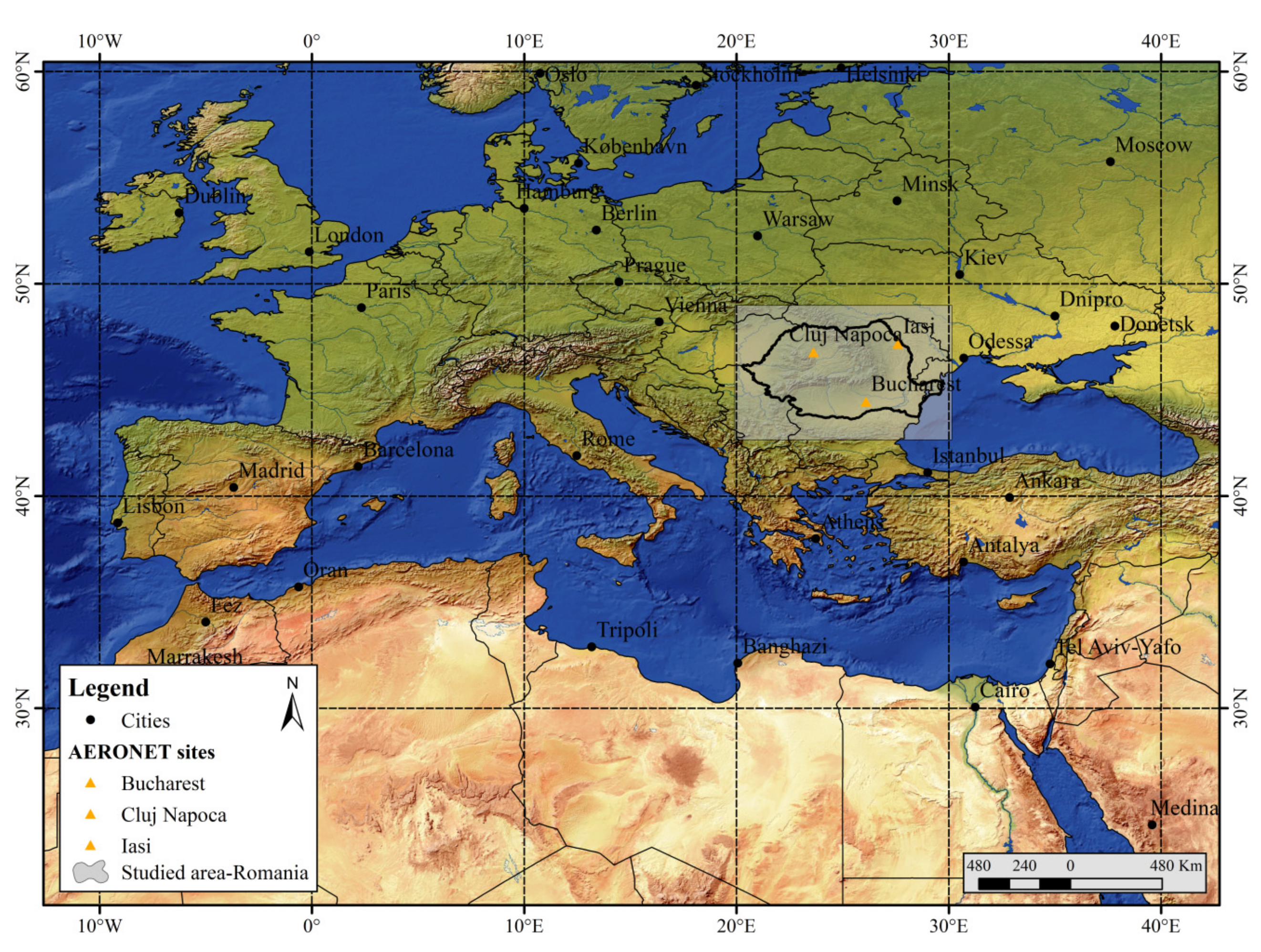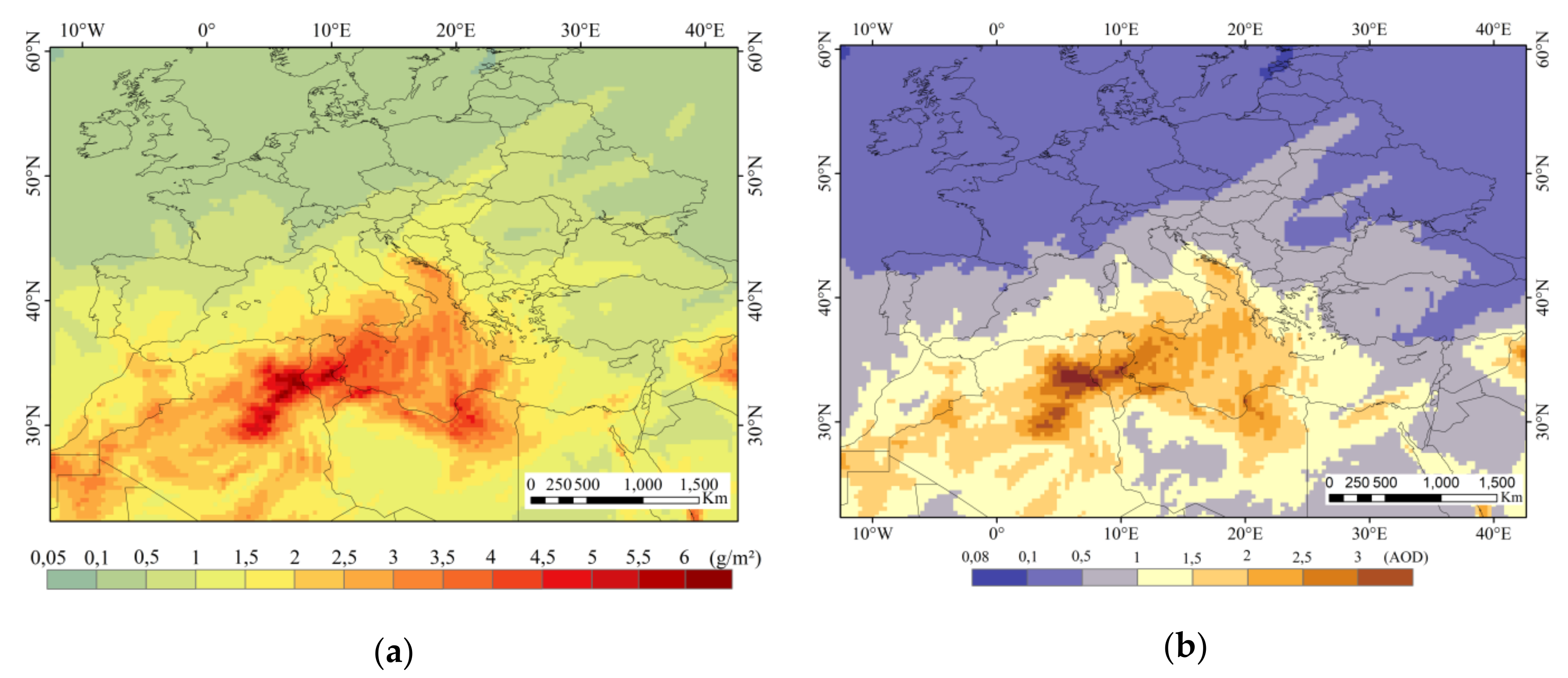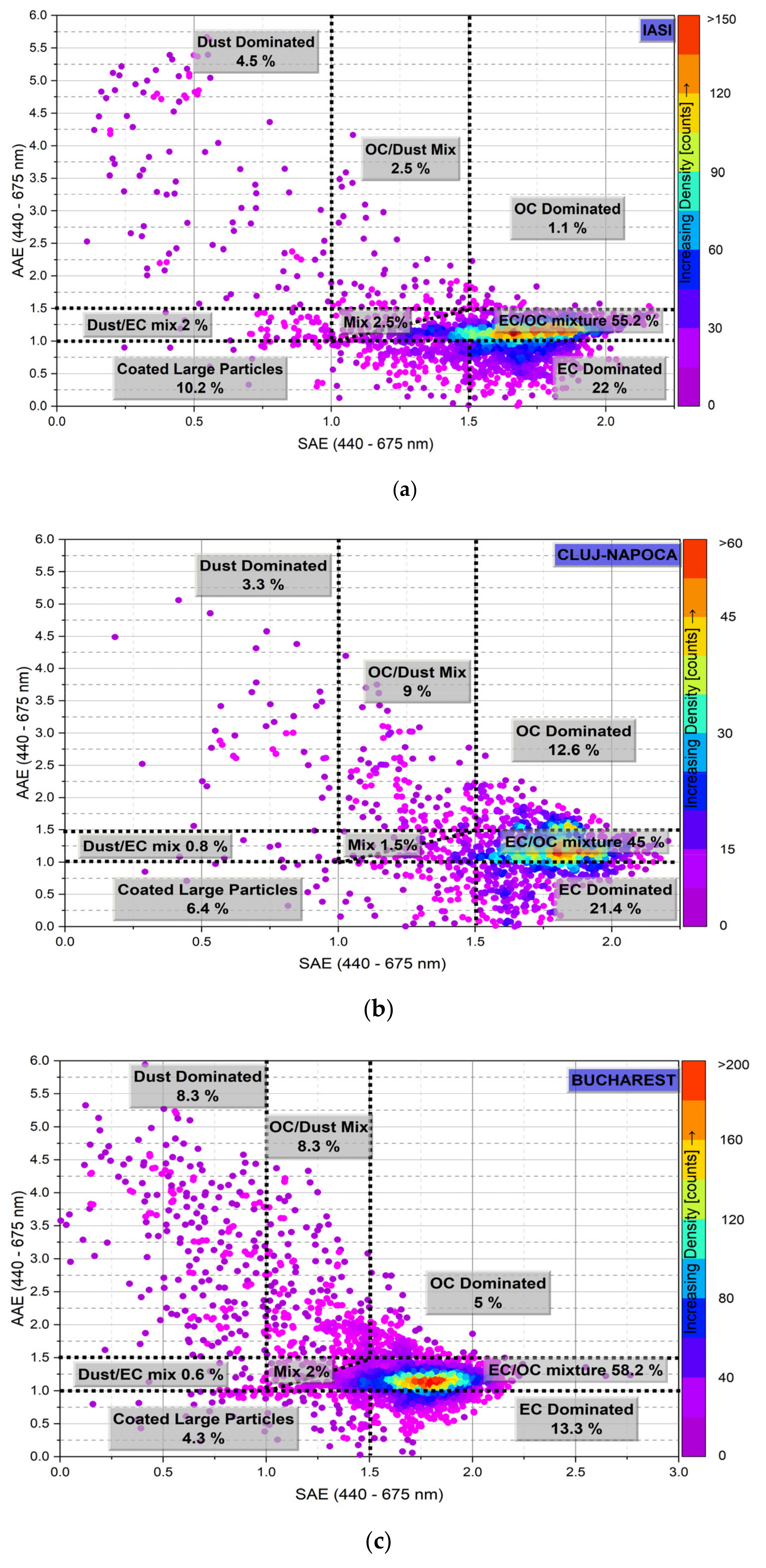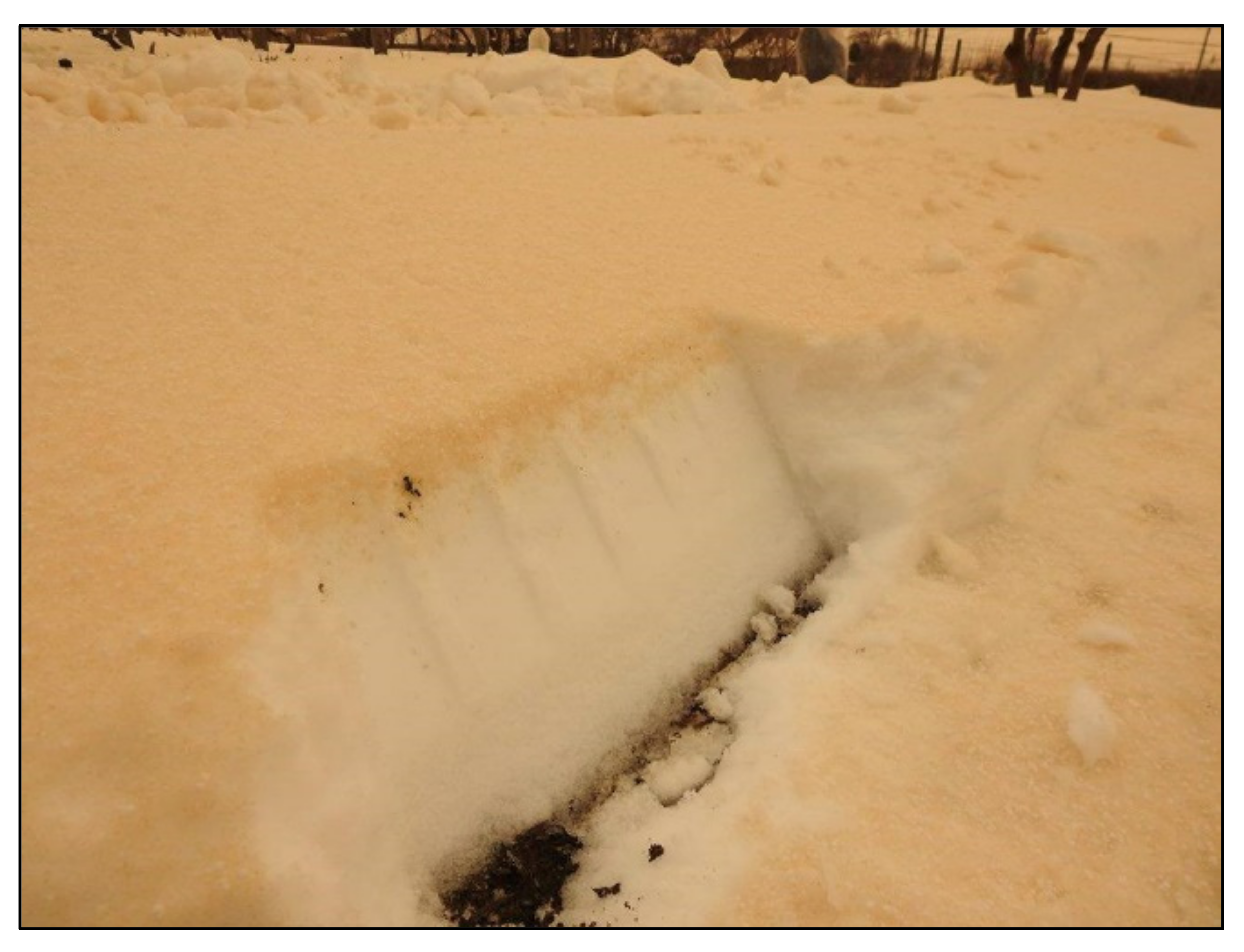Tropospheric Dust and Associated Atmospheric Circulations over the Mediterranean Region with Focus on Romania’s Territory
Abstract
1. Introduction
2. Data and Methodology
2.1. Study Area
2.2. Dust Data from BSC-DREAM8b.v2
2.3. Sun Photometer Data
2.4. Atmospheric Circulation Classification
3. Results and Discussions
3.1. The Dust over the Mediterranean Region the from Forecast Model
3.2. The Dust Load over Romania from Forecast Model
3.3. Dust Occurrence over Romania from AERONET—ACTRIS-RO Observations
3.4. Dust Driven by Atmospheric Circulation
3.5. Case study: The Saharan Dust Transport over Romania on 22–23 March 2018
4. Conclusions
Author Contributions
Funding
Acknowledgments
Conflicts of Interest
References
- Tsoar, H.; Bagnold, R.A. The Physics of Blown Sand and Desert Dunes, Methuen: London, UK, 1941. Prog. Phys. Geog. 1994, 18, 91–96. [Google Scholar] [CrossRef]
- Barkan, J.; Alpert, P.; Kutiel, H.; Kishcha, P. Synoptics of dust transportation days from Africa toward Italy. J. Geophys. Res. 2005, 110, D07208. [Google Scholar] [CrossRef]
- D’Almeida, G.A. Model for Saharan Dust Transport. J. Climate. Appl. Meteor. 1986, 25, 903–916. [Google Scholar] [CrossRef]
- Rodrıguez, S.; Querol, X.; Alastuey, A.; Kallos, G.; Kakaliagou, O. Saharan dust contributions to PM10 and TSP levels in Southern and Eastern Spain. Atmos. Environ. 2001, 35, 2433–2447. [Google Scholar] [CrossRef]
- Goudie, A.S. Dust storms and human health. In Extreme Weather Events and Human Health; Akhtar, R., Ed.; Springer: Cham, Germany, 2020. [Google Scholar] [CrossRef]
- Labzovskii, L.; Toanca, F.; Stefan, S. Determination of saharan dust properties over Bucharest, Romania part 1: Procedures and algorithms. Rom. J. Phys. 2014, 59, 1084–1096. [Google Scholar]
- Labzovskii, L.; Toanca, F.; Nicolae, D. Determination of saharan dust properties over Bucharest, Romania part 2: Study cases analysis. Rom. J. Phys. 2014, 59, 1097–1108. [Google Scholar]
- Pitari, G.; Di Genova, G.; Coppari, E.; De Luca, N.; DiCarlo, P.; Iarlori, M.; Rizi, V. Desert dust transported over Europe: Lidar observations and model evaluation of the radiative impact. J. Geophys. Res. Atmos. 2015, 120, 2881–2898. [Google Scholar] [CrossRef]
- Karagulian, F.; Temimi, M.; Ghebreyesus, D.; Weston, M.; Kondapalli, N.K.; Valappil, V.K.; Aldababesh, A.; Lyapustin, A.; Chaouch, N.; Hammadi, F.; et al. Analysis of a severe dust storm and its impact on air quality using WRF-Chem modeling, satellite imagery, and ground observations. Air. Quality. Atmos. Health 2019, 12, 453–470. [Google Scholar] [CrossRef]
- Prospero, J.M.; Ginoux, P.; Torres, O.; Nicholson, S.E.; Gill, T.E. Environmental characterization of global sources of atmospheric soil dust identified with the Nimbus 7 Total Ozone Mapping Spectrometer (TOMS) absorbing aerosol product. Rev. Geophy. 2002, 40, 1002. [Google Scholar] [CrossRef]
- Marinică, I. Saharan dust transport over Romania. Air. Water. Compon. Environ. 2017, 85–92. [Google Scholar] [CrossRef]
- Ansmann, A.; Bösenberg, J.; Chaikovsky, A.; Camerón, A.; Eckhardt, S.; Eixmann, R.; Freudenthaler, V.; Ginoux, P.; Komguem, L.; Linné, H.; et al. Long-range transport of Saharan dust to northern Europe: The 11–16 October 2001 outbreak observed with EARLINET. J. Geophys. Res. 2003, 108, 4783. [Google Scholar] [CrossRef]
- Michaelidis, S.; Evripidou, P.; Kallos, G. Monitoring and predicting Saharan Desert dust events in the eastern Mediterranean. R. Meteorol. Soc. 1999, 54, 359–365. [Google Scholar] [CrossRef]
- Barcelona Dust Forecast Center. Available online: https://dust.aemet.es/ (accessed on 1 October 2019).
- Eck, T.F.; Holben, B.N.; Reid, J.S.; Dubovik, O.; Smirnov, A.; O’neill, N.T.; Slutsker, I.; Kinne, S. Wavelength dependence of the optical depth of biomass burning, urban, and desert dust aerosols. J. Geophys. Res. Atmos. 1999, 104, 31333–31349. [Google Scholar] [CrossRef]
- Dust Forecast Model from University of Athens. Available online: https://forecast.uoa.gr (accessed on 1 July 2019).
- NASA, EarthData Portal. Available online: https://disc.gsfc.nasa.gov (accessed on 1 November 2019).
- Schulzweida, U. CDO User Guide (version 1.9.8), 2019. Available online: http://doi.org/10.5281/zenodo.3539275 (accessed on 2 April 2020).
- Barcelona Dust Forecast Center. Available online: https://dust.aemet.es/forecast-evaluation/annual-scores?date=201601-201612 (accessed on 14 January 2020).
- Cazorla, A.; Bahadur, R.; Suski, K.J.; Cahill, J.F.; Chand, D.; Schmid, B.; Ramanathan, V.; Prather, K.A. Relating aerosol absorption due to soot, organic carbon, and dust to emission sources determined from in-situ chemical measurements. Atmos. Chem. Phys. 2013, 13, 9337–9350. [Google Scholar] [CrossRef]
- Dubovik, O.; Holben, B.; Eck, T.F.; Smirnov, A.; Kaufman, Y.J.; King, M.D.; Tanré, D.; Slutsker, I. Variability of Absorption and Optical Properties of Key Aerosol Types Observed in Worldwide Locations. J Atmos. Sci. 2002, 59, 590–608. [Google Scholar] [CrossRef]
- Giles, D.M.; Sinyuk, A.; Sorokin, M.G.; Schafer, J.S.; Smirnov, A.; Slutsker, I.; Eck, T.F.; Holben, B.N.; Lewis, J.R.; Campbell, J.R.; et al. Advancements in the Aerosol Robotic Network (AERONET) Version 3 database - Automated near-real-time quality control algorithm with improved cloud screening for Sun photometer aerosol optical depth (AOD) measurements. Atmos. Meas. Tech. 2019, 12, 169–209. [Google Scholar] [CrossRef]
- Russell, P.B.; Bergstrom, R.W.; Shinozuka, Y.; Clarke, A.D.; DeCarlo, P.F.; Jimenez, J.L.; Livingston, J.M.; Redemann, J.; Holben, B.; Dubovik, O.; et al. Absorption Angstrom Exponent in AERONET and related data as an indicator of aerosol composition. Atmos. Chem. Phys. 2010, 10, 1155–1169. [Google Scholar] [CrossRef]
- Cazacu, M.M.; Timofte, A.; Unga, F.; Albina, B.; Gurlui, S. AERONET data investigation of the aerosol mixtures over Iasi area, One-year time scale overview. J. Quant. Spectrosc. Radiat. Transf. 2015, 153, 57–64. [Google Scholar] [CrossRef]
- Sfîcă, L.; Iordache, L.; Ichim, P.; Leahu, A.; Cazacu, M.-M.; Gurlui, S.; Trif, C.-T. The influence of weather conditions and local climate on particulate matter (PM10) concentration in metropolitan area of Iași, Romania. Pres. Environ. Sustain. Develop. 2018, 11, 109–117. [Google Scholar] [CrossRef]
- Mărmureanu, L.; Marin, C.A.; Andrei, S.; Antonescu, B.; Ene, D.; Boldeanu, M.; Vasilescu, J.; Vițelaru, C.; Cadar, O.; Levei, E. Orange Snow—A Saharan Dust Intrusion over Romania During Winter Conditions. Rem. Sens. 2019, 11, 2466. [Google Scholar] [CrossRef]
- Cazacu, M.M.; Tudose, O.G.; Timofte, A.; Rusu, O.; Apostol, L.; Leontie, L.; Gurlui, S. A case study of the behavior of aerosol optical properties under the incidence of a Saharan dust intrusion event. Appl. Ecol. Environ. Res. 2016, 14, 183–194. [Google Scholar] [CrossRef]
- Unga, F.; Cazacu, M.M.; Timofte, A.; Bostan, D.; Mortier, A.; Dimitriu, D.G.; Gurlui, S.; Goloub, P. Study of tropospheric aerosol types over Iasi, Romania, during summer of 2012. Environ. Eng. Manag. J. 2013, 12, 297–303. [Google Scholar]
- Papayannis, A.; Nicolae, D.; Kokkalis, P.; Binietoglou, I.; Talianu, C.; Belegante, L.; Tsaknakis, G.; Cazacu, M.M.; Vetres, I.; Ilic, L. Optical, size and mass properties of mixed type aerosols in Greece and Romania as observed by synergy of lidar and sunphotometers in combination with model simulations: A case study. Sci. Total Environ. 2014, 500, 277–294. [Google Scholar] [CrossRef] [PubMed]
- Brown, H.; Liu, X.; Feng, Y.; Jiang, Y.; Wu, M.; Lu, Z.; Wu, C.; Murphy, S.; Pokhrel, R. Radiative effect and climate impacts of brown carbon with the Community Atmosphere Model (CAM5). Atmos. Chem. Phys. 2018, 18, 17745–17768. [Google Scholar] [CrossRef]
- Nicolae, V.; Talianu, C.; Andrei, S.; Antonescu, B.; Ene, D.; Nicolae, D.; Dandocsi, A.; Toader, V.E.; Ștefan, S.; Savu, T.; et al. Multiyear typology of long-range transported aerosols over Europe. Atmosphere 2019, 10, 482. [Google Scholar] [CrossRef]
- Beck, C. Zirkulations dynamische Variabilität im Bereich Nordatlantik-Europa seit 1780-dissertation; Selbstverlag des Instituts für Geographie: Würzburg, Germany, 2000. [Google Scholar]
- Beck, C.; Jacobeit, J.; Jones, P.D. Frequency and within-type variations of large-scale circulation types and their effects on low-frequency climate variability in Central Europe since 1780. Int. J. Clim. 2007, 27, 473–491. [Google Scholar] [CrossRef]
- Dee, D.P.; Uppala, S.M.; Simmons, A.J.; Berrisford, P.; Poli, P.; Kobayashi, S.; Andrae, U.; Balmaseda, M.A.; Balsamo, G.; Bauer, P.; et al. The ERA-Interim reanalysis: Configuration and performance of the data assimilation system. Quart. J. Roy. Meteor. Soc. 2011, 137, 553–597. [Google Scholar] [CrossRef]
- Philipp, A.; Bartholy, J.; Beck, C.; Erpicum, M.; Esteban, P.; Fettweis, X.; Coauthors. Cost733cat–A database of weather and circulation type classifications. Phys. Chem. Earth. Parts A/B/C 2010, 35, 360–373. [Google Scholar] [CrossRef]
- Kallos, G.; Astitha, M.; Katsafados, P.; Spyrou, C. Long range tranport of anthropogenically and naturally produced partciulate matter in the Mediterranean and North Atlantic: Current state of knowledge. J. Appl. Meteorol. Climatol. 2007, 46, 1230–1251. [Google Scholar] [CrossRef]
- Sandu, I. Climate of Romania; Romanian Academy Publishing House: Bucharest, Romania, 2008. [Google Scholar]
- Dobri, R.V.; Sfîcă, L.; Ichim, P.; Harpa, G.V. The distribution of the monthly 24-hour maximum amount of precipitation in Romania according to their synoptic causes. Geogr. Tech. 2017, 12, 62–72. [Google Scholar] [CrossRef][Green Version]
- Ajtai, N.; Stefanie, H.; Ozunu, A. Description of aerosol properties over Cluj-Napoca derived from AERONET sun photometric data. Environ. Eng. Manag. J. 2013, 12, 227–232. [Google Scholar] [CrossRef]
- Ajtai, N.; Stefanie, H.; Arghius, V.; Meltzer, M.; Costin, D. Characterization of aerosol optical and microphysical properties over North-Western Romania in correlation with predominant atmospheric circulation patterns, International Multidisciplinary Scientific Geo Conference. Surv. Geol. Min. Ecol. Manag. 2017, 17, 375–382. [Google Scholar]
- Belegante, L.; Cazacu, M.M.; Timofte, A.; Toanca, F.; Vasilescu, J.; Rusu, M.I.; Ajtai, N.; Stefanie, H.I.; Vetres, I.; Ozunu, A.; et al. Case study of the first volcanic ash exercise in Romania using remote sensing techniques. Environ. Eng. Manag. J. 2015, 14, 2503–2504. [Google Scholar]
- Nemuc, A.; Belegante, L.; Radulescu, R. One year of sunphotometer measurements in Romania. Rom. J. Phys. 2011, 56, 550–562. [Google Scholar]
- Roșu, I.A.; Cazacu, M.M.; Prelipceanu, O.; Agop, M. A Turbulence-Oriented Approach to Retrieve Various Atmospheric Parameters Using Advanced Lidar Data Processing Techniques. Atmosphere 2019, 10, 38. [Google Scholar] [CrossRef]
- Lack, D.A.; Cappa, C.D. Impact of brown and clear carbon on light absorption enhancement, single scatter albedo and absorption wavelength dependence of black carbon. Atmos. Chem. Phys. 2010, 10, 4207–4220. [Google Scholar] [CrossRef]
- Sfîcă, L.; Croitoru, A.E.; Iordache, I.; Ciupertea, A.F. Synoptic Conditions Generating Heat Waves and Warm Spells in Romania. Atmosphere 2017, 8, 50. [Google Scholar] [CrossRef]
- Caian, M.; Andrei, M.D. Late-Spring severe blizzard events over eastern Romania: A conceptual model of development. Atmosphere 2019, 10, 770. [Google Scholar] [CrossRef]
- WMO Sand and Dust storm warning advisory and Assessment System. Available online: https://sds-was.aemet.es (accessed on 1 August 2019).










© 2020 by the authors. Licensee MDPI, Basel, Switzerland. This article is an open access article distributed under the terms and conditions of the Creative Commons Attribution (CC BY) license (http://creativecommons.org/licenses/by/4.0/).
Share and Cite
Țîmpu, S.; Sfîcă, L.; Dobri, R.-V.; Cazacu, M.-M.; Nita, A.-I.; Birsan, M.-V. Tropospheric Dust and Associated Atmospheric Circulations over the Mediterranean Region with Focus on Romania’s Territory. Atmosphere 2020, 11, 349. https://doi.org/10.3390/atmos11040349
Țîmpu S, Sfîcă L, Dobri R-V, Cazacu M-M, Nita A-I, Birsan M-V. Tropospheric Dust and Associated Atmospheric Circulations over the Mediterranean Region with Focus on Romania’s Territory. Atmosphere. 2020; 11(4):349. https://doi.org/10.3390/atmos11040349
Chicago/Turabian StyleȚîmpu, Simona, Lucian Sfîcă, Radu-Vlad Dobri, Marius-Mihai Cazacu, Andrei-Ion Nita, and Marius-Victor Birsan. 2020. "Tropospheric Dust and Associated Atmospheric Circulations over the Mediterranean Region with Focus on Romania’s Territory" Atmosphere 11, no. 4: 349. https://doi.org/10.3390/atmos11040349
APA StyleȚîmpu, S., Sfîcă, L., Dobri, R.-V., Cazacu, M.-M., Nita, A.-I., & Birsan, M.-V. (2020). Tropospheric Dust and Associated Atmospheric Circulations over the Mediterranean Region with Focus on Romania’s Territory. Atmosphere, 11(4), 349. https://doi.org/10.3390/atmos11040349





